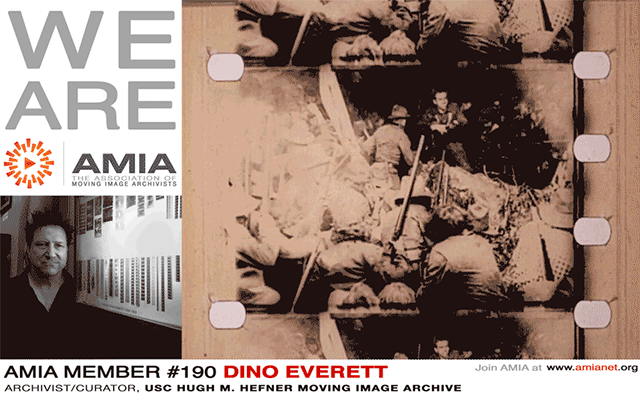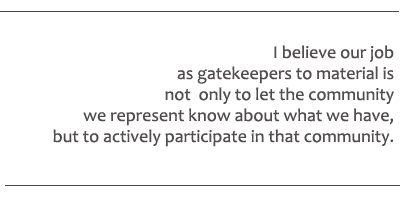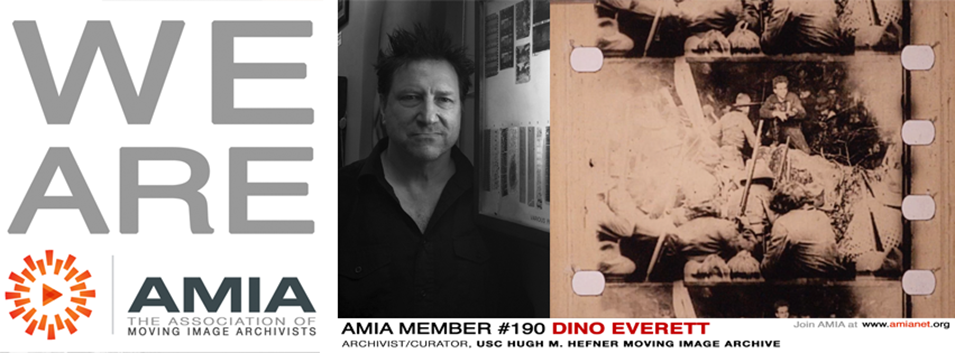


Tell us about the GIF footage in your We Are AMIA ad.
I would say the importance is really from the format, not just the content. Too often we push the unusual formats off to the side since they are harder to deal with, but more often than not they provide the sole surviving material on many rare silent titles. 28mm (which is what the GIF comes from) is the perfect example. None of us would have ever seen any of The Perils of Pauline if it weren’t for the surviving cutdown on 28 mm. This goes for hundreds of other silents. This particular one is an early Vitagraph short entitled He Knew Lincoln from 1914, featuring Ralph Ince (as Abraham Lincoln) and Anita Stewart.
A large part of your work involves preserving the early projects of the next Steven Spielberg, Christopher Nolan, Ken Burns, etc. In your words, why is that important?
Taking care of so many student projects is the perfect example of why we should not let our personal prejudices influence our decision making in regards to which films we should protect. Amateur and student-based narratives are probably some of the least exciting films to the average filmgoer until many years after the fact. In 1969, no one cared about a film entitled Captain Voyeur that had some sloppy technical errors in it. It didn’t win any awards for the filmmaker and didn’t feature anyone famous in the cast. But jump ahead 30 years and its discovery generated some of the most press we have ever received here at the USC Hugh M. Hefner Moving Image Archive, because it was the first proper student film from John Carpenter. Our job is to take care of the material in our various archives, not tell people what is or is not worthy of saving.
You’ve dubbed yourself “the Punk Rock Archivist” – what’s the story behind that moniker?
I believe it was actually something that began getting attributed to me based on my punk rock past (and forever present). I remember Grover (Crisp) introduced me at The Reel Thing as an archivist and punk rocker, and then Kaitlin Conner really came up with it for a blog post on the Indiana University website. I love it because I start my presentations by stating that everything I do in this field is influenced by what I call my “punk rock brain,” in that I look at things from the perspective of “How can I do that?” I’ll see something presented at The Reel Thing and I know we can never afford to spend the money to get a certain result, so I try to think of DIY methods like wet gate scanning or dealing with deteriorated nitrate. I wind up being able to do many things that maybe I didn’t know how to do a year ago simply because punk rock gave me the fearlessness to just do it, regardless of how insane it might sound, or how everyone else says it is a waste of time. The early punk scene involved seeing people who are in a similar situation to you and reaching out to them to help, and do things together.
We are building an archive of punk rock media at USC, thanks to a suggestion by Professor David James. We have a growing collection of unique, one-of-a-kind audio, video and film from the original first few years of punk, and even received an NFPF grant to restore a previously unseen punk film from 1979 called In The Red by Liz Keim and Karen Merchant that features bands like The Avengers, The Dils and others. Of course I still play punk rock in bands and back up old punk legends, and I am currently making a punk rock documentary. So basically it applies to me across the board!
What is the role of archiving/preservation as something that benefits a community?
I believe our job as gatekeepers to material is not only to let the community we represent know about what we have, but to actively participate in that community. For many, this is done by loaning out prints so that other communities can benefit from holdings, but this can also be done by partnering up with local organizations that have similar missions. For instance, we will always loan prints to Film Forum and repertory theatres but we also try to inform others when we might have something they could benefit from using.
In regards to Echo Park Film Center, they represent the kids in the community that are interested in filmmaking and the subculture of artists who still enjoy shooting their movies on celluloid film. We partner with them on everything from projecting movies guerilla style on street corners throughout the city using generators, to opening up the archive’s equipment to them so they can produce new material more affordably.
We also have begun a film lab project that includes us hooking up some old equipment like a Bell & Howell Model C Color printer, an RCA optical camera, and will be expanding into digital film out printing, and perfing/slitting various film stocks, to virtually anything we can assist in. I believe the days of archives being a passive member of the community are over and we need to actively participate whenever possible. I often scan film for local filmmakers for virtually free. I let people come in and use our flatbeds. I’ve given away working equipment to others in town, and I regularly train students and volunteers on how to work with film and then send them away with their own projector and small stack of films to practice on their own.
We are not just holders of content; we are protectors of history, which means sometimes we have to make sure that the information that is more cultural and not found in a book or video gets shared as well.
Do you have a story of “the one that got away” – something you wish you could have saved? Why does that motivate you?
I am a fairly optimistic person, so I often believe that lost films are just that—currently “lost” rather than “permanently erased from history.” The film that I hope to find more than anything would be the Unknown Purple (1923) by Roland West, since I am personally obsessed with him and I am dying to know what the “special color process” was. Also, any Clara Bow film that is listed as lost, and things that may have never been saved in the first place, such as the 1960 BBC series called Film Club, which was all about amateur filmmaking. I’d love to find and save all of the many hundreds of British 10 best winners from the 1940s to the 1980s. There are countless USC student films, such as John Carpenter’s thesis film Lady Madonna, for which I have sound but no picture. Also film formats, since that is as important to me as the films themselves.
My crown jewel would be one of the 9.5 Pathe sound on disc projectors that were housed inside of a specially made Pooley wooden cabinet, or the Martin Harper 16mm sound system projector. I want these things so I can restore them and then show people how they worked with public demonstrations, not simply to shine them up to put them behind glass. Just like people want to see all the archival films that are in the archives, I believe archival technology was supposed to do something, and won’t be properly restored until you can bring it back in front of people doing that thing it was designed to do again.
